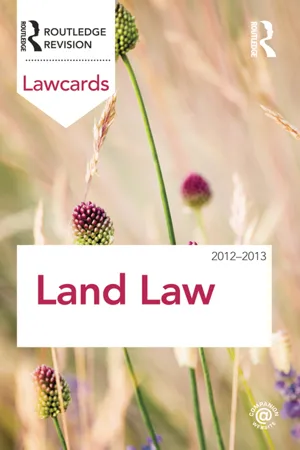
- 168 pages
- English
- ePUB (mobile friendly)
- Available on iOS & Android
Land Law Lawcards 2012-2013
About this book
Routledge Lawcards are your complete, pocket-sized guides to key examinable areas of the undergraduate law curriculum and the CPE/GDL. Their concise text, user-friendly layout and compact format make them an ideal revision aid. Helping you to identify, understand and commit to memory the salient points of each area of the law, shouldn't you make Routledge Lawcards your essential revision companions?
Fully updated and revised with all the most important recent legal developments, Routledge Lawcards are packed with features:
-
- Revision checklists help you to consolidate the key issues within each topic
- Colour coded highlighting really makes cases and legislation stand out
- Full tables of cases and legislation make for easy reference
- Boxed case notes pick out the cases that are most likely to come up in exams
- Diagrams and flowcharts clarify and condense complex and important topics
'...an excellent starting point for any enthusiastic reviser. The books are concise and get right down to the nitty-gritty of each topic.' - Lex Magazine
Routledge Lawcards are supported by a Companion Website offering:
- Flashcard glossaries allowing you to test your understanding of key terms and definitions
- Multiple Choice Questions to test and consolidate your revision of each chapter
- Advice and tips to help you better plan your revision and prepare for your exams
Titles in the Series: Commercial Law; Company Law; Constitutional Law; Contract Law; Criminal Law; Employment Law; English Legal System; European Union Law; Evidence; Equity and Trusts; Family Law; Human Rights; Intellectual Property Law; Jurisprudence; Land Law; Tort Law
Frequently asked questions
- Essential is ideal for learners and professionals who enjoy exploring a wide range of subjects. Access the Essential Library with 800,000+ trusted titles and best-sellers across business, personal growth, and the humanities. Includes unlimited reading time and Standard Read Aloud voice.
- Complete: Perfect for advanced learners and researchers needing full, unrestricted access. Unlock 1.4M+ books across hundreds of subjects, including academic and specialized titles. The Complete Plan also includes advanced features like Premium Read Aloud and Research Assistant.
Please note we cannot support devices running on iOS 13 and Android 7 or earlier. Learn more about using the app.
Information
1
Fundamental concepts
| Definitions of Land | ■ |
| Concept of Property | ■ |
| Test for fixture or chattel | ■ |
| Concept of tenure and estates | ■ |
| Concept of rights, estates and interests | ■ |
| Concept of notice | ■ |
| Concept of fee simple absolute in possession | ■ |
| Requirements for a valid contract for sale | ■ |
| Requirements for a valid conveyance of land | ■ |
STATUTORY DEFINITIONS OF LAND

PROBLEMS OF PROPERTY ARISING WHERE CHATTELS ARE AFFIXED TO LAND
◗ Holland v Hodgson [1872]
Facts
Held

◗ D’EYNCOURT V GREGORY [1886]
Facts
Held
CONCEPT OF TENURE AND ESTATES
CONCEPTS OF RIGHTS, ESTATES AND INTERESTS

CONCEPT OF ‘PURCHASER WITHOUT NOTICE’
Table of contents
- Cover
- Title
- Copyright
- Contents
- Table of Cases
- Table of Statutes
- Table of Statutory Instruments
- Table of European Legislation
- Abbreviations
- How to use this book
- 1. Fundamental concepts
- 2. Conveying title to land with unregistered title
- 3. Transferring title to land with registered title
- 4. Adverse possession and boundaries
- 5. Trusts of land
- 6. Resulting trusts, constructive trusts, proprietary estoppel and licences
- 7. Leases
- 8. Mortgages
- 9. Easements and profits à prendre
- 10. Freehold covenants
- 11. Putting it into practice …